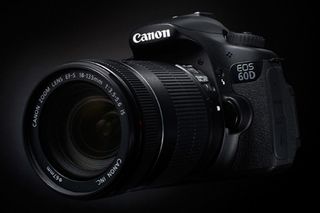Why you can trust TechRadar
Far be it for us to be snobbish about plastic, we'd never expect to see a modern Formula 1 race car built out of cast iron. Technically speaking, the 60D is built on an aluminium chassis and has a shell that's made of polycarbonate resin strengthened with glass fibre, so it should prove reasonably tough.
It's just that, compared with cameras like the Canon 7D and 50D, or the Nikon D90 and D300s, the Canon 60D really does feel a bit plasticky, more like Canon's line of budget cameras including the EOS 450D, EOS 500D and EOS 550D. The only plus point is that it shaves 67g off the bodyweight of the 50D.
Dials, buttons and switches feel mostly of good quality but some are a little fiddly. For example, the main on/off switch is on the edge of the main shooting mode dial, so it would be easy to switch shooting modes accidentally when turning the camera on or off. Presumably for this reason, Canon has added a locking button to the top of the mode dial, so you need to press this down with one finger while rotating the dial with your thumb and another finger.

One thing that sets the Canon 60D apart from cheaper Canon DSLRs is that it features the time-honoured top-plate LCD. Again, however, this has been downsized from the 50D's secondary LCD and no longer includes quality mode or white balance information. You gain an extra control button along the front edge of the top LCD, making four in all, but they're not Canon's usual dual-mode buttons and have only one action each, comprising AF, Drive, ISO and Metering modes. An extra button activates the top LCD's illumination.
Ultimately, the EOS 60D's plastic build doesn't impair handling and the camera feels solid and comfortable in use. Ergonomics are good and rubberised areas on the hand grip, back plate and left hand side of the camera add non-slip confidence.

The obscure little PC that wanted to be a big NAS — super compact Maiyunda M1 doesn't cost that much, offers up to 40TB SSD storage, runs Windows and has 4 Gigabit Ethernet ports

Image site Abload going offline reminds me of how much online content we've permanently lost

Gemini's next evolution could let you use the AI while you browse the internet
